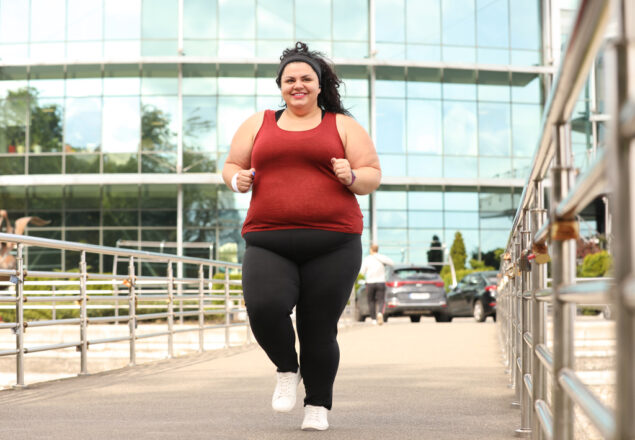Go to a big park on the weekend, and you’ll see at least a few overweight people running.
Running for overweight people isn’t just possible. It’s healthy, it’s fun, and it can help you lose weight. But you have to do it right, and that means paying attention to a few things.
Read on to find out how to start running when you are overweight.
In This Article
In This Article:
Is Running Good for Overweight People?
Being overweight is no excuse for not running. While you need to start slowly, the benefits of running when you are overweight go beyond weight loss.
- Burn calories. A 30-minute jog can burn between 200–500 calories.
- Sleep better. Running, like other forms of moderate to vigorous exercise, helps you fall asleep more quickly and sleep better.
- Lowers your risk of cardiovascular disease and other diseases. Overweight people have a higher risk of cardiovascular disease than people with a normal BMI. But running regularly can help you mitigate this risk.
- Better memory. Running regularly may even increase the size of the hippocampus. This part of the brain plays a crucial role in the formation of memories.
- Boosts your immune system. Running regularly strengthens your immune system. It can reduce your risk of catching a cold.
- Running boosts your mood. You don’t need a scientific study to tell you that. Just go for a moderate run and see how great you feel.
By helping you get the recommended 150 minutes of moderate-intensity exercise per week, running can have an overall health-promoting effect on your body.
With that said, running is a high-impact activity. It can be hard on your joints, especially if you’re overweight.
Running too much too fast can lead to overuse injuries like shin splints and even stress fractures that can put you out of commission.
But running for overweight people isn’t a problem if you start slow and follow a moderate-intensity training plan, which can tell you how much to run based on your BMI.
Does Running Help Lose Weight?
Running is one of the best forms of exercise for losing weight. More than burning calories, it can directly reduce belly fat and body fat.
Research indicates that running at a moderate to high intensity can reduce belly fat even if you don’t change your diet. High-intensity running is especially effective at reducing body fat, according to a study on middle-aged women.
Belly fat is associated with a higher risk of many diseases, including type 2 diabetes and heart disease.
It can also speed up your metabolism, helping your body keep burning calories even after you stop running.
However, when running for weight loss, it’s important to do it regularly and at a moderate to high intensity.
How many calories do you burn when running?
The number of calories you burn while running depends on the intensity of your run, weight, gender, and other factors.
For example, a 75-kilogram (165-pound) runner running for 30 minutes at a moderate pace will burn 391 calories, according to a simple calculator.
The same runner speeding up to a fast pace will burn 476 calories during the same run.
How to Start Running When You’re Overweight
Itching to lace up your sneakers and head out for a run already? Well, don’t just yet. Here are a few important things you should be doing to ensure you avoid health risks.
See your doctor
Being overweight makes you more prone to cardiovascular disease. Your joints also have to withstand greater forces, putting you at higher risk of running injuries.
It’s also important to consider any existing medical conditions that affect your weight. Seeing your doctor before you start following a running plan is important. It may seem like a hassle, but it can prevent serious problems later on.
Your doctor may recommend a stress test. You may also want to have him or her review your running plan.
Get the right running shoes
You don’t want to run in sneakers or old running shoes. The extra weight will increase the pressure on your lower body and joints, making you more vulnerable to injury.
Visit a store that sells specialty running shoes. Have your gait analyzed to find shoes that provide optimal cushioning and arch support.
Compression gear to help with chafing
Wearing the right gear can make running when you are overweight easier and more pleasant. Wicking fabrics reduce the likelihood of ending up with chafed skin after a long run.
Compression socks and tights can also reduce chafing. They may even reduce swelling and cramps, making longer runs less tough on your lower legs.
Fitness Tips for Running When Overweight
Once you’ve checked with your doctor and are set up and ready for a run, here are a few important things to keep in mind.
Start small and walk first
Running subjects your lower body to impact forces that are up to 3 times greater than walking. This can increase the risk of overuse injuries like the runner’s knee and shin splints.
As an overweight runner, you can build endurance by walking and then transition to running, gradually increasing your mileage.
For a perfect start, follow a personalized running plan that factors in your body weight and current fitness level.
Switch to a run/walk strategy
A study published in the journal Nature found an association between body fat percentages and lung function. Getting started running when you are overweight may leave you out of breath.
This can make it difficult to complete a run without stopping every hundred steps. That is not only frustrating, but it can reduce the effectiveness of running.
Another option is to alternate running with shorter periods of walking at a light to moderate pace. This will help you recover while staying in motion.
Taking it to the next level
Combining walking with running will help you build endurance. Then it’s time to start pushing yourself harder. But do it in a gradual way that allows for progress while minimizing the risk of injuries.
Increasing your running speed can help you burn more calories. You can also progressively increase your running distance.
But add no more than 10% to the length of your runs from one week to the next. Jumping from a 3-kilometer run to a 5-kilometer run won’t be any fun for your joints.
Once you get into good shape, you can up the challenge with hill runs and interval training. Fartlek runs, in which you play with speeds, can also be fun and effective.
Listen to your body
Running too much when you are overweight can cause shin splints. Shin splints are a common overuse injury.
According to MedlinePlus, shin splints are caused by the inflammation of muscles, tendons, and bone tissue.
Runner’s knee, ankle sprains, and stress fractures are other injuries you risk if you go too fast too soon.
During the height of running, it’s easy to set unrealistic goals. That’s why it’s crucial to listen to the signals your body is sending you.
If your body is sore and tired, give yourself enough rest. If you feel you can push harder, go for it. But don’t bring yourself to the brink of exhaustion.
Add some strength training
Having a high body mass can significantly reduce your aerobic performance, according to a 2014 study.
But if you combine running for weight loss with a strength training workout, you can achieve a leaner body that, in turn, will boost your running performance.
Going to the gym for a full-body strength workout twice a week is great. But you can also work your body at home with a pair of dumbbells.
As a runner, working your leg muscles can boost your running performance. From squats and wall sits to lunges and calf raises, there are many exercises you can do to strengthen your legs.
Recover well
Don’t run every day. Give yourself at least one day of rest in between runs and two or more between longer runs.
Factor in any strength training you may do and increase your rest period accordingly.
Don’t forget about cross-training. It can help you build endurance and strength without putting too much stress on your joints. Try yoga, swimming, and cycling.
Nutrition Tips for Running When Overweight
To lose weight running, you have to run a caloric deficit. Rather than skipping meals, aim to eat balanced meals free from surplus calories.
- Eat enough protein to facilitate recovery. Most sources recommend 1.3–1.6 grams of protein per kg of body weight.
- Avoid saturated fats and other unhealthy fats.
- Don’t starve yourself before runs, or you may struggle to complete them.
- Eat enough carbs to fuel your runs and workouts.
- Stay hydrated by taking a water bottle with you on runs.
How to Stay Motivated
Getting started with running is easy. It’s keeping going that’s hard. Setting running goals and updating them as you rack up the miles is one way to stay motivated.
Another is to run with friends or become part of a running community. Running apps can make it easier to connect with other runners.
Running before and after transformations can be spectacular. Following other people’s progress can help you reach your goals.
You also want to reward yourself for the milestones you complete. A new pair of running shoes and some wicking running gear are useful, calorie-free rewards.
Common Issues for Overweight Runners
Overweight runners face some challenges when they first start adding up the miles. But while annoying at times, these issues can be overcome.
Difficulties breathing
Running increases your heart rate, making you breathe faster. This leads to fast, shallow breathing that doesn’t provide enough oxygen.
Pay attention to your body as you run. Practice deep breathing, feeling the air inflate your belly. Try to sync your breathing with your steps.
Overuse injuries
Shin splints and runner’s knee are common overuse injuries. Rather than having to deal with them, it’s best to prevent them.
Don’t run too much. And don’t run every day. Give your body enough time to rest and recover. Follow a personalized running plan to maximize results while avoiding injury.
Chafing
Chafing can occur where your skin touches and becomes sweaty, like the underarms or inner thighs.
Overweight people running in wicker clothing don’t have to worry so much about chafing. Wicker clothing is also comfortable.
Takeaways
Before you head out for a run, here are some takeaways:
- Running when you are overweight helps you burn calories and is very healthy, but you have to start slow.
- Increase your running pace and mileage gradually to avoid overuse injuries.
- Give your runner’s body time to adapt to the effort.
- Don’t starve yourself – eat enough protein to aid recovery.
- Invest in quality running gear to avoid chafing and minimize the impact on your lower body.
- Stay motivated by pursuing running goals and joining a running community.
- Follow a personalized running plan to lose weight.
Frequently Asked Questions
Is running okay for people who are overweight?
Yes, running can be beneficial for individuals who are overweight as it provides an effective way to engage in cardiovascular exercise and promote weight loss. However, it’s essential to approach running with consideration for individual fitness levels and potential impact on joints. Starting with a mix of brisk walking and light jogging before gradually increasing running intensity can help build endurance and reduce the risk of injury. Additionally, combining running with a balanced diet and other forms of exercise, such as strength training and flexibility exercises, can contribute to overall health and weight management. It’s advisable to consult with a healthcare professional or fitness expert to create a personalized plan that aligns with individual health conditions and fitness goals.
How long should I run if I’m overweight?
If you’re overweight and considering incorporating running into your routine, it’s important to start gradually and listen to your body. Begin with a comfortable duration, perhaps around 20 to 30 minutes, incorporating a mix of walking and jogging. As your stamina improves, gradually increase the duration and intensity. Pay attention to how your body responds, and ensure you’re not pushing yourself too hard to avoid overexertion or injury. It’s quality over quantity, so focus on maintaining a pace that allows you to sustain the activity and enjoy the process. Starting with shorter sessions and gradually building up can help your body adapt to the new exercise, making it a sustainable and enjoyable part of your fitness journey. Consulting with a fitness professional or healthcare provider can provide personalized guidance based on your specific health status and fitness goals.
Is it harder for heavier people to run?
Running can pose additional challenges for heavier individuals due to the increased impact on joints and the cardiovascular system. The extra weight places more stress on the knees, ankles, and hips, potentially making running more challenging and increasing the risk of injury. However, with proper precautions and a gradual approach, heavier individuals can still enjoy the benefits of running. Starting with low-impact exercises like brisk walking and incorporating interval training to gradually build endurance can help ease the transition into running. Investing in supportive footwear, maintaining good running form, and listening to one’s body are crucial. Weight loss through a combination of regular exercise and a balanced diet may also reduce the physical demands of running over time. It’s essential for individuals of all sizes to approach running sensibly, taking into account their unique fitness levels and making adjustments to create a sustainable and enjoyable exercise routine.
Does being fat affect running?
Yes, body weight can impact running, and individuals with excess weight may face specific challenges. The additional weight places increased stress on joints, particularly in the lower body, which can lead to a higher risk of injuries such as shin splints or stress fractures. Carrying extra weight also requires more effort and energy during running, potentially affecting overall stamina and endurance. However, it’s important to note that people of all body sizes can engage in running successfully with proper precautions. Gradual progression, appropriate warm-ups, supportive footwear, and a focus on overall fitness can help mitigate the challenges associated with running for individuals with excess weight. Listening to one’s body, incorporating rest days, and consulting with healthcare or fitness professionals for personalized guidance can contribute to a safe and enjoyable running experience.
References:
- Vincent, H.K. and Vincent, K.R., 2013. Considerations for initiating and progressing running programs in obese individuals. PM&R, 5(6), pp.513-519.
- Bertelsen, M.L., Hansen, M., Rasmussen, S. and Nielsen, R.O., 2018. How do novice runners with different body mass indexes begin a self-chosen running regime?. journal of orthopaedic & sports physical therapy, 48(11), pp.873-877.
- Zdziarski, L.A., Chen, C., Horodyski, M., Vincent, K.R. and Vincent, H.K., 2016. Kinematic, cardiopulmonary, and metabolic responses of overweight runners while running at self-selected and standardized speeds. PM&R, 8(2), pp.152-160.
- Buist, I. and Bredeweg, S.W., 2011. Higher risk of injury in overweight novice runners. British journal of sports medicine, 45(4), pp.338-338.
- Williams, P.T., 1997. Evidence for the incompatibility of age-neutral overweight and age-neutral physical activity standards from runners. The American journal of clinical nutrition, 65(5), pp.1391-1396.














